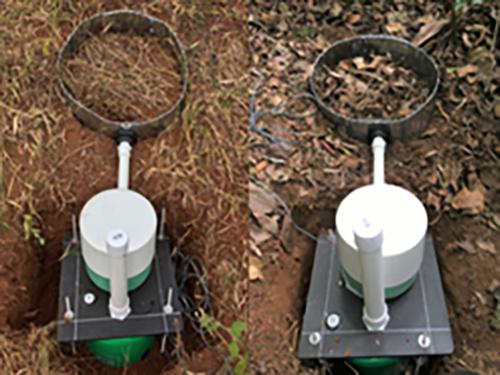当前位置:
X-MOL 学术
›
Hydrol. Process.
›
论文详情
Our official English website, www.x-mol.net, welcomes your
feedback! (Note: you will need to create a separate account there.)
Assessing plot‐scale impacts of land use on overland flow generation in Central Panama
Hydrological Processes ( IF 2.8 ) Pub Date : 2020-09-30 , DOI: 10.1002/hyp.13924 Sidney A. Bush 1 , Robert F. Stallard 2 , Brian A. Ebel 3 , Holly R. Barnard 1
Hydrological Processes ( IF 2.8 ) Pub Date : 2020-09-30 , DOI: 10.1002/hyp.13924 Sidney A. Bush 1 , Robert F. Stallard 2 , Brian A. Ebel 3 , Holly R. Barnard 1
Affiliation

|
Land use in Panama has changed dramatically with ongoing deforestation and conversion to cropland and cattle pastures, potentially altering the soil properties that drive the hydrological processes of infiltration and overland flow. We compared plot‐scale overland flow generation between hillslopes in forested and actively cattle‐grazed watersheds in Central Panama. Soil physical and hydraulic properties, soil moisture and overland flow data were measured along hillslopes of each land‐use type. Soil characteristics and rainfall data were input into a simple, 1‐D representative model, HYDRUS‐1D, to simulate overland flow that we used to make inferences about overland flow response at forest and pasture sites. Runoff ratios (overland flow/rainfall) were generally higher at the pasture site, although no overall trends were observed between rainfall characteristics and runoff ratios across the two land uses at the plot scale. Saturated hydraulic conductivity (Ks) and bulk density were different between the forest and pasture sites (p < 10−4). Simulating overland flow in HYDRUS‐1D produced more outputs similar to the overland flow recorded at the pasture site than the forest site. Results from our study indicate that, at the plot scale, Hortonian overland flow is the main driver for overland flow generation at the pasture site during storms with high‐rainfall totals. We infer that the combination of a leaf litter layer and the activation of shallow preferential flow paths resulting in shallow saturation‐excess overland flow are likely the main drivers for plot scale overland flow generation at the forest site. Results from this study contribute to the broader understanding of the delivery of freshwater to streams, which will become increasingly important in the tropics considering freshwater resource scarcity and changing storm intensities.
中文翻译:

评估巴拿马中部土地利用对土地流产生的样地规模影响
巴拿马的土地使用发生了巨大变化,包括持续的森林砍伐以及向农田和牛牧场的转化,潜在地改变了土壤特性,从而推动了渗透和陆地流动的水文过程。我们比较了巴拿马中部森林和活跃的牛群放牧流域的山坡之间的样地规模的陆上径流产生。沿每种土地利用类型的山坡测量了土壤的物理和水力学特性,土壤水分和陆上流量数据。将土壤特征和降雨数据输入到一个简单的一维代表性模型HYDRUS-1D中,以模拟陆上水流,我们以此推断森林和牧场的陆上水流响应。牧场的径流比(陆流/降雨)通常较高,尽管在样地尺度上,两种土地利用的降雨特征和径流比之间没有观察到总体趋势。饱和水力传导率森林和牧场之间的K s和容重不同(p <10 -4)。在HYDRUS-1D中模拟陆上流量产生的产出比林场上产生的产出更多,类似于牧场现场记录的陆上流量。我们的研究结果表明,在样地范围内,霍顿河的陆上径流是在暴雨总数高的暴风雨期间牧草场产生陆上径流的主要驱动力。我们推断,叶子凋落物层和浅层优先流径的激活导致浅层饱和-过量的陆上径流的组合可能是森林站点上地积规模陆上径流产生的主要驱动力。这项研究的结果有助于更广泛地了解淡水向河流的输送,考虑到淡水资源稀缺和风暴强度变化,这在热带地区将变得越来越重要。
更新日期:2020-09-30
中文翻译:

评估巴拿马中部土地利用对土地流产生的样地规模影响
巴拿马的土地使用发生了巨大变化,包括持续的森林砍伐以及向农田和牛牧场的转化,潜在地改变了土壤特性,从而推动了渗透和陆地流动的水文过程。我们比较了巴拿马中部森林和活跃的牛群放牧流域的山坡之间的样地规模的陆上径流产生。沿每种土地利用类型的山坡测量了土壤的物理和水力学特性,土壤水分和陆上流量数据。将土壤特征和降雨数据输入到一个简单的一维代表性模型HYDRUS-1D中,以模拟陆上水流,我们以此推断森林和牧场的陆上水流响应。牧场的径流比(陆流/降雨)通常较高,尽管在样地尺度上,两种土地利用的降雨特征和径流比之间没有观察到总体趋势。饱和水力传导率森林和牧场之间的K s和容重不同(p <10 -4)。在HYDRUS-1D中模拟陆上流量产生的产出比林场上产生的产出更多,类似于牧场现场记录的陆上流量。我们的研究结果表明,在样地范围内,霍顿河的陆上径流是在暴雨总数高的暴风雨期间牧草场产生陆上径流的主要驱动力。我们推断,叶子凋落物层和浅层优先流径的激活导致浅层饱和-过量的陆上径流的组合可能是森林站点上地积规模陆上径流产生的主要驱动力。这项研究的结果有助于更广泛地了解淡水向河流的输送,考虑到淡水资源稀缺和风暴强度变化,这在热带地区将变得越来越重要。











































 京公网安备 11010802027423号
京公网安备 11010802027423号